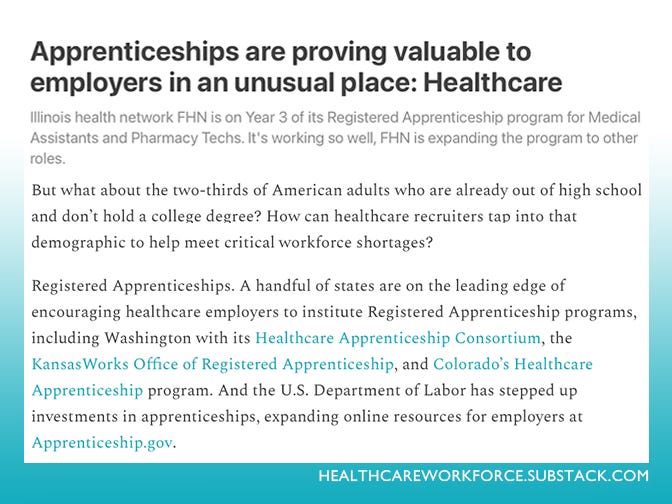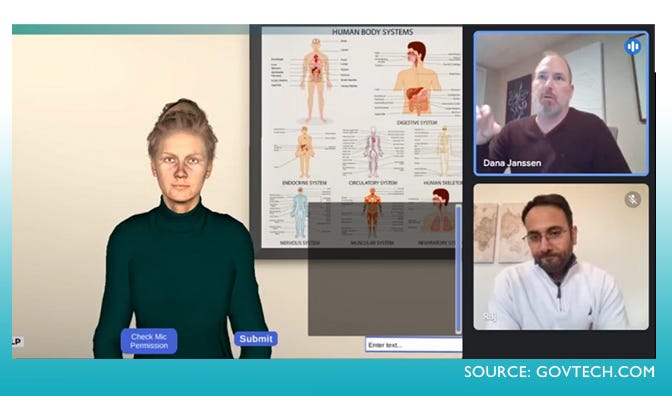What do apprenticeships and AI have in common?
Both are increasingly viewed as untapped solutions to ease the burdens of staffing shortages
A new piece in Health Leaders Media highlights a real-life healthcare apprenticeship program that sorta broke the mold for training brand-new health workers when FHN started the pilot program in 2020.
The November 16, 2023, edition of this newsletter introduced the cutting-edge program at Illinois healthcare network FHN, which initially partnered with a nearby community college but then in 2021 linked up with online training and credentialing provider MedCerts to grow and expand its apprenticeship pilot.

Now FHN executive Len Carter is sharing first-hand about how the organization has benefitted, encouraging other health employers to consider trying apprenticeships for entry-level and early-career healthcare roles like Medical Assistant.
It’s an effective model, Carter writes, and he lays out six reasons organizations should implement apprenticeships:
Immediately expands the applicant pool
Reduces academic recruiting demands
Support is readily available
Serves as built-in vetting
Creates career pathways
Builds a sustainable talent pipeline
Read Len’s piece at HealthLeadersMedia.com; find the detailed story of how their program got started and how it’s fared in the Nov. 16 HWR.
Missouri’s CoxHealth puts some nursing staff on virtual duty; turnover drops by more than half
Becker’s Hospital Review details how CoxHealth in Springfield, Missouri, reduced its nursing tunrover rate from 25% in early 2022 to about 11% now — by creating a virtual nursing program.
“The virtual care team at CoxHealth consists of nurses, hospitalists, pharmacists and respiratory therapists,” Becker’s reports. “These employees remotely monitor patients and interact with them via camera, collaborating closely with the bedside care team to address patient needs, creating a ‘virtual safety net’ for patients,” a hospital executive said.
Bonus benefits of the program: A decrease in falls, fewer hospital-acquired infections, and a nursing staff that is less burned out. Initially a 90-day pilot, the program was made permanent last summer.
AI as a lifesaver for time-strapped providers?
Several new reports in recent weeks highlight the enormous potential for generative AI to reduce paperwork and administrative burdens for doctors, nurses, and other health workers.
CNBC covered the recent HIMSS conference in Orlando, where “Ambient clinical documentation was the talk of the conference,” attended by over 30K health and tech professionals.
This newsletter has touched on AI’s potential to aid healthcare staff in tasks such as helping doctors summarize visits and “sit” with hospital patients.
Now the tech is beginning to explode, CNBC reports.
Ambient clinical documentation “allows doctors to record conversations with patients to automatically turn them into clinical notes and summaries using AI,” according to CNBC. “The hottest new technology for doctors promises to bring back an age-old health-care practice: face-to-face conversations with patients.”
Administrative workloads are a major problem for clinicians across the U.S. health-care system, CNBC noted. A February survey by Athenahealth found that more than 90% of physicians report feeling burned out on a “regular basis,” largely because of the paperwork required for every patient appointment.
Watch CNBC’s video about it here.
AI is also growing as a training tool: Clinical simulations
GovTech.com recently wrote about MedCerts (the sponsor of this newsletter) new clinical simulator platform, which combines AI with augmented reality to simulate training scenarios for nursing and medical students to practice diagnosing and interacting with patients.

MedCerts’ online medical training platform uses large language models to simulate interactions with virtual patient “avatars,” allowing health sciences students to practice skills such as bedside manner and diagnosing patients.
MedCerts’ Chief Product Officer Dana Janssen told GovTech that the platform allows students to ask these avatars questions, then assess their conditions and develop treatment plans based on their interactions. He said the goal is to give students more confidence working in clinical environments by developing their “soft” social skills in sensitivity, professionalism and communication.
This kind of simulation tool allows universities to “bring the clinical environment to the learner,” Janssen said, noting that several universities have already made use of their medical training modules, including Duke University, the University of Texas, and Elon University.
Check out the full report here.
Google and AI in healthcare? Glad you asked
A notable postscript: Google is getting into the healthcare generative AI game too; this new blog from Google discusses the company’s progress in healthcare AI development. More details in a future edition.
Shout-out to Healthcare Workforce Report sponsors
The Healthcare Workforce Report newsletter is generously supported by MedCerts.
For information on supporting HWR, email HealthcareWorkforce@substack.com.





